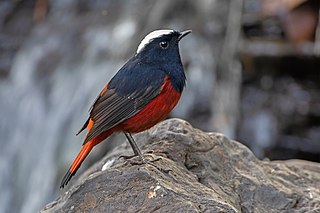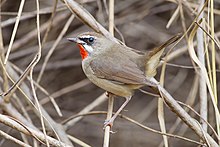
The Ryukyu robin is a bird endemic to the Ryūkyū Islands, of Japan. The Okinawa robin previously was considered a subspecies.

The thrush nightingale, also known as the sprosser, is a small passerine bird that was formerly classed as a member of the thrush family Turdidae, but is now more generally considered to be an Old World flycatcher, Muscicapidae. It, and similar small European species, are often called chats.

The Old World flycatchers are a large family, the Muscicapidae, of small passerine birds restricted to the Old World, with the exception of several vagrants and two species, bluethroat and northern wheatear, found also in North America. These are mainly small arboreal insectivores, many of which, as the name implies, take their prey on the wing. The family is relatively large and includes 357 species, which are divided into 54 genera.

The blue rock thrush is a species of chat. This thrush-like Old World flycatcher was formerly placed in the family Turdidae. It breeds in southern Europe, northwest Africa, and from Central Asia to northern China and Malaysia. The blue rock thrush is the official national bird of Malta and was shown on the Lm 1 coins that were part of the country's former currency.

The Siberian blue robin is a small passerine bird that was formerly classified as a member of the thrush family, Turdidae, but is now more generally considered to belong to the Old World flycatcher family, Muscicapidae. It and similar small European species are often called chats. Recent research suggests that this species and some other East Asian members of Luscinia should be classified in a new genus, together with the Japanese and Ryūkyū robins. The genus name Larvivora comes from the Neo-Latin larva meaning caterpillar and -vorus meaning eating, and cyane is Latin for "dark-blue".

The rufous-tailed robin is a small passerine bird. Its breeding range extends from southern Siberia and the Sea of Okhotsk to southern China and southeastern Asia.

Luscinia is a genus of smallish passerine birds, containing the nightingales and relatives. Formerly classed as members of the thrush family Turdidae, they are now considered to be Old World flycatchers (Muscicapidae) of the chat subfamily (Saxicolinae). The chats are a lineage of Old World flycatchers that has evolved convergently to thrushes.

The mountain chat or mountain wheatear is a small insectivorous passerine bird that is endemic to southwestern Africa.

The white-capped redstart or white-capped water redstart is a passerine bird of the Old World flycatcher family Muscicapidae native to the Indian Subcontinent,Southeast Asia, much of China, and to certain regions of Central Asia.

The white-bellied redstart is a species of bird of the family Muscicapidae. It is found in Bhutan, China, India, Laos, Myanmar, Nepal, Pakistan, Thailand, and Vietnam, where its natural habitat is temperate forests.

The blackthroat, also known as the black-throated robin or black-throated blue robin, is a species of bird in the family Muscicapidae. It breeds in north-central China but its wintering grounds are uncertain. It has been recorded as a vagrant in northwest Thailand. Its natural habitat is bamboo thickets within coniferous forest at altitudes of 3000–3,400 metres. It is threatened by habitat loss.

The firethroat also known as David's rubythroat or Père David's orangethroat is a species of passerine bird in the family Muscicapidae, found in western and central parts of China. It breeds in Sichuan, China, and winters primarily in the Indian subcontinent. Its wintering range spans across Bangladesh, Bhutan, India, Nepal, Tibet and Myanmar. Its natural habitat is temperate forests. It is threatened by habitat loss.

The Himalayan rubythroat is a species of passerine bird in the family Muscicapidae. It is closely related to the Siberian rubythroat which however lacks the distinctive white tail-tips and white tail bases. It was also previously considered conspecific with the Chinese rubythroat, together called the white-tailed rubythroat. It is found along the Tien Shan and Himalayan ranges from Afghanistan to Myanmar. Three subspecies are recognized across its wide range.

The rufous-headed robin is a species of passerine bird in the family Muscicapidae. It is found in central China. Its natural habitats are temperate forests and temperate shrubland. This poorly known species is thought to be threatened by habitat loss.

The Herero chat is a species of passerine bird belonging to the family Muscicapidae, the chats and Old World flycatchers. It is the only species in the monospecific genus Namibornis and it has a restricted range in southwestern Africa.

Phoenicurus is a genus of passerine birds in the Old World flycatcher family Muscicapidae, native to Europe, Asia and Africa. They are named redstarts from their orange-red tails. They are small insectivores, the males mostly brightly coloured in various combinations of red, blue, white, and black, the females light brown with a red tail. A molecular phylogenetic study published in 2010 led to a reorganization of the Old World flycatchers family in which the two species in Rhyacornis and the single species in Chaimarrornis were merged into Phoenicurus.

The fulvous-chested jungle flycatcher is a species of bird in the Old World flycatcher family Muscicapidae. It is found in Brunei, Indonesia, Malaysia, Myanmar, and Thailand. Its natural habitat is subtropical or tropical moist lowland forests.

Calliope is a genus of passerine birds in the Old World flycatcher family Muscicapidae.

Larvivora is a genus of small passerine birds belonging to the Old World flycatcher family Muscicapidae that occur in central and eastern Asia.

The Chinese rubythroat is a small passerine bird in the family Muscicapidae. It is closely related to the Siberian rubythroat which however lacks the distinctive white tail-tips and white tail bases. It was also previously considered conspecific with the Himalayan rubythroat, together called the white-tailed rubythroat. It is found along the Himalayan ranges from Pakistan to Myanmar.

























